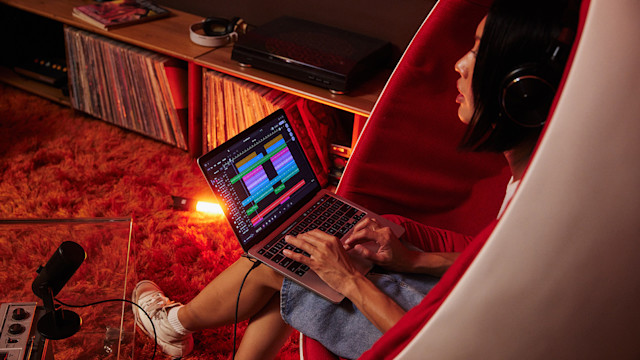Your Introduction to the Vocoder
October 14, 2024 - The vocoder is an iconic effect which is instantly recognisable. Learn how to harness the capabilities of the Vocoder for your music in this comprehensive introduction!

You’ll be able to instantly recognise the sound of a vocoder when you hear it. You’ve heard it on Michael Jackson’s ‘P.Y.T.’ and more recently Zedd, Maren Morris, and Grey’s track ‘The Middle.’ Daft Punk and Pink Floyd were some of the most popular artists to bring the sound of the vocoder into cultural prominence, but since its inception in the 1920s people have been integrating vocoded sounds with their music.
Understanding how a vocoder works isn’t immediately obvious- and there is a lot of confusion about what a vocoder is in the first place (it’s not the thing with the clear tube you put in your mouth, but we’ll get to that later). This guide will take you through how a vocoder works, how they came about, and how you can get the best out of a vocoder in your music!
What is a Vocoder?
The development of the first vocoder began in the 1920s, with development eventually finished in 1928. Homer Dudley of Bell Labs wanted to create a device that would reduce the bandwidth of the human voice, so conversations could happen over longer distances. The word itself is a portmanteau of the words ‘voice’ and ‘encoder’ - a large part of vocoder use in the early 20th century was centred around secured radio transmission and protecting the sound of the human voice against interception.
How Does A Vocoder Work?
The Modulator
A vocoder requires two audio sources that work alongside each other to form a vocoded sound. The first is the modulator, which is normally the human voice, but it can be any source of audio. The voice/modulator is passed through a selection of filters, which split up the audio into separate frequency bands. Once the voice/modulator has been separated into multiple frequency bands, band pass filters (filters which only allow a certain frequency through) are then applied, and the vocal is tuned to the centre frequency of its frequency band. In essence, the voice is chopped up, reorganized, filtered, and then tuned.
The Carrier
So, the sound of the voice has been rearranged. Now it’s time to carry those rearranged signals through another instrument, which is normally a synthesizer, but again this can be a variety of different instruments. The carrier is sent through the bank of filters as well, and the vocoder adjusts the level of each filter based on the harmonic content of the modulating signal. It’s probably got a bit complex now, but allow me to explain…
The Result
The best analogy I’ve heard to help understand how a vocoder works is to almost imagine it as your lungs, vocal chords, and your vocal tract working together, but in synthesizer form. Your lungs create air and push that air to your vocal chords. This is a kind of carrier. When the sound leaves your mouth, the shape of your vocal tract can change and alter your voice- this is an example of modulation. This is how a vocoder works, by changing the carrier signal according to the characteristics of the modulator signal. All of these signals are combined to make the iconic robot voice sound, which has a futuristic quality without losing any of the emotion, phrasing or passion found in an effect like auto-tune or pitch correcting software.

The Talkbox
Ever seen people on stage playing a synthesizer, whilst a clear tube goes into their mouth, making them sound like a robot with impeccable pitch? That’s a talkbox!
Even though it sounds quite similar to a vocoder in the robotic sounds it produces, it actually operates around a different set of principles. The harmonics and the sound coming out of the clear tube, are filtered and structured based on the musician’s mouth. A vocoder uses more electronic processing, whereas a Talkbox operates through more mechanical means.
Take a listen to Bon Jovi’s ‘Livin’ On A Prayer’ or Bruno Mars’ ‘24K Magic.’ Then compare them to the sound of a vocoder heard on ‘P.Y.T.’ or ‘The Middle.’ You’ll hear that the Talkbox is almost closer to a wah-wah pedal, whereas a vocoder brings in more harmonic information.
What kinds of signals can be used?
Voice (Modulator)
Using the voice as a modulator is the most widely recognised use of a vocoder. When somebody speaks or sings into a microphone, the vocoder will analyse the frequency content of the voice and where it sits on the spectrum.
Drums (Carrier)
Looking for rhythmic, staccato/chopped effects? Percussion and beats can be used as a type of carrier.
Guitars and Live Instrumentation (Carrier)
Acoustic sounds, guitars, and strings are great options to use as carriers. Bass guitars can sound really amazing and funky when used in this way. You’ll end up with a walking, talking bass!
Synthesizers (Carrier)
Synthesizers are the instrument most commonly associated with vocoders. Saw and square waves contribute deep, harmonic tones that are incredibly pleasing to listen to.
Ambience & Ear Candy (Carrier)
If you want, you can go nuts and use any ear candy or ambient noises as carriers. The results may not be as consistent, but they’ll definitely be interesting.
Tips for using a Vocoder as a Plugin
If you’re getting to grips with using a vocoder for the first time, it’s probably best to use it in the most accessible way possible, which is using the voice as a modulator, and maybe a synthesizer as the carrier. Here’s a few tips if you’re using a vocoder as a plugin:
Record some vocals, and get them as clean as possible. The cleaner they are, the better the vocoder will operate. You’ll want to EQ away some of the low end rumble and unwanted frequencies. Apply a high pass filter, and get rid of everything below about 100-120hz.
Using presets on vocoder plugins is a great way to get to grips with what kind of results each set of parameters gets. Take a look at how different parameters impact your sounds, and play around with them as a starting point.
Tweak the wet and dry settings, to hear how a vocoder impacts a dry signal, and what harmonic information comes through.
Remember: you can always experiment with vocoders. While they are most well known for being used alongside the human voice and a synthesizer, there are no real boundaries on what you can experiment with. Even if you’re unsure of what you’re doing, you can still get creative and have fun.
Conclusion
The Vocoder is an iconic and immensely powerful effect when used in a track. It can be an intimidating thing to understand, but sometimes the best results come out of using an instrument or plugin, in a way that it maybe wasn’t intended. There are absolutely no rules when it comes to using a vocoder, just experiment and be creative!
About the author
Max McLellan is a composer, songwriter, and audio engineer with credits ranging across film, TV and radio. He provides composition, mixing, and mastering services through his company MKM Audio.
Beginnen Sie noch heute mit Soundtrap!